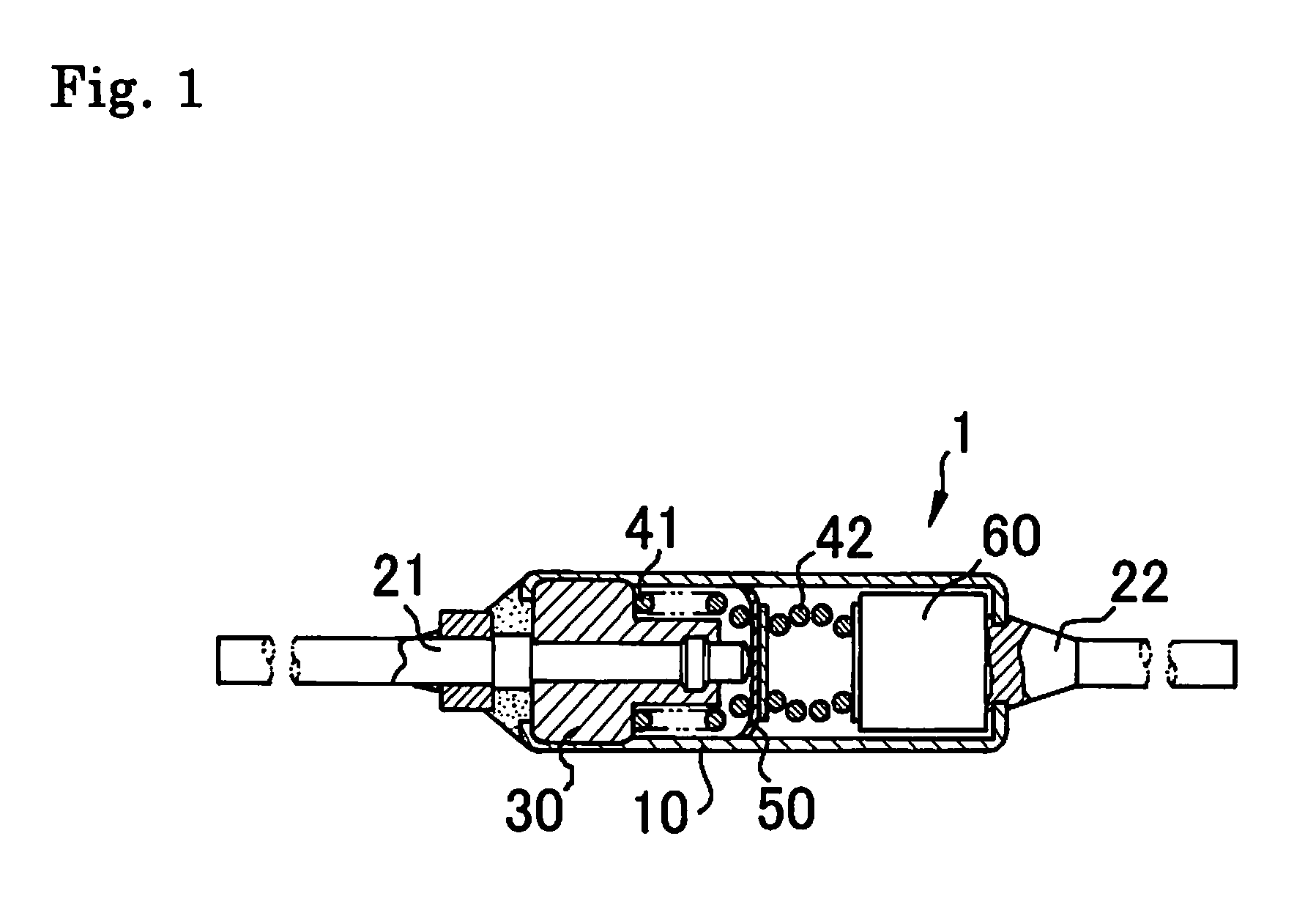Electrode material having clad structure
a technology of clad structure and electrodes, applied in the field of electrode materials, can solve problems such as thermal fuse operation failure, and achieve the effect of good melt adhesion resistance and stable maintenan
- Summary
- Abstract
- Description
- Claims
- Application Information
AI Technical Summary
Benefits of technology
Problems solved by technology
Method used
Image
Examples
first embodiment
[0023]In the embodiment, an electrode material having a two-layer structure consisting of a contact point layer and a base layer was produced. A wire material (wire diameter: 4.5 mm) of a Ag—CuO alloy produced by subjecting a Ag—Cu alloy (Cu concentrations: 5, 10, and 12 mass %) to internal oxidation was provided and was rolled to 7 mm in width×0.6 mm in thickness by rolling processing to thereby produce a Ag—CuO alloy (contact point layer) tape. Moreover, a wire material (wire diameter: 5.5 mm) of Cu (oxygen-free copper) or an Cu alloy (Cu-0.15 mass % Sn alloy, Cu-1 mass % Ni alloy) was subjected to rolling processing to 7 mm in width×1.5 mm in thickness to thereby produce a Cu or Cu alloy (base layer) tape. Then, these two metal tapes were stacked and rolled in an inert atmosphere to thereby perform clad joining. This clad material was further rolled and subjected to slit processing to thereby provide a tape for an electrode material. At this time, the thickness of the Ag—CuO allo...
second embodiment
[0026]In the embodiment, an electrode material having a three-layer structure where a Ag layer as a contact layer was joined was produced and evaluated. First, a wire material (wire diameter: 4.0 mm) of Ag (purity: 99.9 or more) was provided and was rolled to 7 mm in width×0.1 mm in thickness by rolling processing to produce a Ag tape. Then, a Ag—CuO alloy tape and a Cu or Cu alloy tape which were produced as in the First Embodiment were stacked and rolled in an inert atmosphere to thereby perform clad joining. Thereafter, rolling and slit processing were performed as in First Embodiment to thereby provide a tape for the electrode material. At this time, the thickness of the Ag—CuO alloy (contact point layer) was 20 μm, the thickness of Cu or the Cu alloy (base layer) was 62 μm, and the thickness of Ag (contact layer) was 2 μm (84 μm in total).
[0027]This tape material produced above was cut out to produce test pieces, and characteristic evaluation thereof was performed. The evaluati...
third embodiment
[0029]In the embodiment, an electrode material having a four-layer structure where a Ag layer as an intermediate layer was joined was produced, and the effect of improving the joinability between the contact point layer and the base layer was inspected. The Ag tape material produced in Second Embodiment was used, and the Ag—CuO alloy tape, the Ag tape, the Cu or Cu alloy tape, and Ag tape of the First and Second Embodiments were stacked and rolled in an inert atmosphere to thereby perform clad joining. Then, rolling and slit processing were performed to thereby provide a tape for the electrode material. At this time, the thickness of the Ag—CuO alloy (contact point layer) was 20 μm, the thickness of Ag (intermediate layer) was 2 μm, the thickness of Cu or the Cu alloy (base layer) was 60 μm, and the thickness of Ag (contact layer) was 2 μm (84 μm in total).
[0030]This tape material produced above was cut out to thereby produce test pieces, and characteristic evaluation thereof was pe...
PUM
| Property | Measurement | Unit |
|---|---|---|
| temperature | aaaaa | aaaaa |
| operating temperature | aaaaa | aaaaa |
| width×0 | aaaaa | aaaaa |
Abstract
Description
Claims
Application Information
 Login to View More
Login to View More - R&D
- Intellectual Property
- Life Sciences
- Materials
- Tech Scout
- Unparalleled Data Quality
- Higher Quality Content
- 60% Fewer Hallucinations
Browse by: Latest US Patents, China's latest patents, Technical Efficacy Thesaurus, Application Domain, Technology Topic, Popular Technical Reports.
© 2025 PatSnap. All rights reserved.Legal|Privacy policy|Modern Slavery Act Transparency Statement|Sitemap|About US| Contact US: help@patsnap.com


